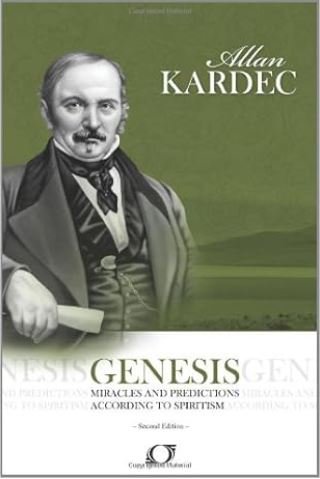
The Spiritist doctrine was codified by Allan Kardec through the teachings of higher order spirits, teaching us about spiritual life, reincarnation, evolution, mediumship and answers to the most fundamental questions about our existence.
Join our meetings, services, activities and events for a more guided learning journey!
Who Was Allan Kardec?
Allan Kardec (1804–1869) was a French educator and the founder of Spiritism, a spiritual philosophy that explores the relationship between the material and spiritual worlds. Born as Hippolyte Léon Denizard Rivail, he adopted the pen name Allan Kardec after becoming interested in the phenomenon of spirit communication. Kardec’s most influential work, The Spirits’ Book, published in 1857, laid the foundation for Spiritism by presenting the teachings of high-order spirits on topics such as life, death, reincarnation, and moral growth.
Kardec’s contributions continue to inspire millions worldwide, offering a path of spiritual enlightenment, personal transformation, and a deeper understanding of life’s purpose. His work is the foundation of the Spiritist doctrine, codified in the following books:
The Spirits’ Book (1857)
The foundational text of Spiritism, this book is a compilation of answers given by spirits to Kardec’s questions about life, death, the afterlife, reincarnation, and moral evolution. It explores the nature of the soul, the spirit world, and the purpose of human existence, serving as the cornerstone of Spiritist philosophy.
The Mediums’ Book (1861)
This book provides a detailed guide to mediumship and spirit communication. It explains the types of mediums, the process of communicating with spirits, and the role of mediums in Spiritism. It is considered a practical manual for those interested in understanding or developing their mediumistic abilities.
The Gospel According to Spiritism (1864)
A reinterpretation of the teachings of Jesus Christ through the lens of Spiritism, this book emphasizes the moral lessons of the Gospel. Kardec explores how the teachings of Christ align with Spiritist principles, focusing on love, charity, and spiritual progress.
Heaven and Hell (1865)
This book examines the nature of the afterlife, including the concepts of heaven, hell, and purgatory, from a Spiritist perspective. Kardec presents real-life spirit communications to demonstrate the conditions of the soul after death, reinforcing the idea that our actions in life determine our spiritual state in the afterlife.
The Genesis, Miracles and Predictions According to Spiritism (1868)
In this work, Kardec explores the origins of the universe and humanity, examining miracles and prophecies in light of Spiritist philosophy. He distinguishes between natural laws and divine intervention, offering a rational approach to understanding spiritual phenomena.
Recommended:
Listen daily to Kardec Radio on YouTube or check their website at www.kardecradio.com
Recommended:
Check the United States Spiritist Federation - USSF on YouTube or check their website at www.spiritistus.com
Who Was Francisco (Chico) Cândido Xavier?
Born in Pedro Leopoldo (MG) on April 2, 1910, Chico Xavier was the son of the poor worker João Cândido Xavier and the laundress Maria João de Deus.
At the age of five, he became orphaned of his mother. Due to difficulties, his father was forced to entrust some of his nine children to the care of friends and relatives. Consequently, for the following two years, Francisco was raised by his godmother, Rita de Cássia, who mistreated and abused him.
With pronounced mediumship from the age of 5, it was during this time that Chico first made contact with his deceased mother while praying in the yard. She asked him to endure the mistreatment, as it would make him strong for the battles to come.
When little Chico was nine years old, his father married Cidália Batista, a kind and charitable woman, who insisted on bringing all the children into the same house to care for them as if they were her own. At Cidália’s insistence, Chico was enrolled in public school, completing the primary course in 1924. After that, he did not return to study.
At the age of 17, he lost his stepmother Cidália and found himself facing the insanity of a sister, which he discovered was caused by an obsessive process. This led to his first spiritist session at home, where he was introduced to Spiritism.
In July 1927, he began practicing psychography. In 1931, the spirit Emmanuel manifested for the first time, becoming his spiritual mentor. Emmanuel warned him that the work would be long and arduous, and the success of this partnership would depend on three conditions: “discipline, discipline, discipline.”
In 1932, the book “Parnaso de Além-Túmulo” was published, a collection of poetry dictated by spirits of Brazilian and Portuguese poets, which had a huge impact on the press and public opinion. During this period, Chico Xavier joined the federal public service as an assistant in the Ministry of Agriculture, where he never had an absence.
In 1935, he published his second mediumistic work “Cartas de Uma Morta” (Letters from a Dead Person), by the spirit of his mother.
In 1943, a new spiritual entity emerged, signing its works with the pseudonym André Luiz, responsible for a magnificent collection of eleven books, starting with “Nosso Lar” (Our Home).
In addition to psychography, he also practiced psychophony, clairvoyance, clairaudience, prescription, physical effects (including materializations), among other practices. He psychographed in languages he did not know (xenoglossia).
Unrestricted love, friendship and charity, strict discipline, simplicity, and renunciation were the key elements of his sublimated mediumship.
In 1959, he moved to Uberaba (MG), where he continued his mediumistic activities in public meetings at the Christian Spiritist Communion.
His work was always focused on spreading Spiritism, supporting those in need, and providing comfort through psychographed letters to mothers who had experienced the passing of their children to the Spirituality.
He psychographed more than 400 books, including messages from the spirits of André Luiz, Emmanuel, Bezerra de Menezes, Humberto de Campos, Casimiro Cunha, Veneranda, Néio Lucio, Hilário Silva, Cornélio Pires, Auta de Souza, Maria Dolores, Meimei, Anália Franco, Eurípedes Barsanulfo, and thousands of Spirits, with all copyrights granted to spiritist organizations and charitable institutions.
He lived exclusively from his own financial resources.
He did not accept money or gifts and did not keep the presents he received. He did not consider himself a missionary.
Many of his works have already been translated into various languages such as English, French, Spanish, Esperanto, Japanese, Greek, etc.
He participated in the “Pinga-Fogo” program on July 28, 1971. The medium appeared live, broadcast nationwide (which was rare for television stations at the time). Initially scheduled for one hour, it extended to over three hours. It achieved the highest audience ever recorded at that time in the history of Brazilian TV, with 75% of Brazilian televisions tuned in. At the end of the Pinga-Fogo Program, Chico Xavier stood up and recited the Lord's Prayer with the audience, moving everyone.
He conducted frequent food collection campaigns and distributions to families assisted biweekly with fraternal soup, in addition to food distribution to homeless people.
With a fragile and debilitated body, he faced various health issues throughout his life: angina, which weakened his physical resistance, worsened by pneumonia and heart problems, labyrinthitis crises, hypertension, glaucoma, which left him blind in one eye, three surgeries, difficulties in moving and speaking, etc.
On June 30, 2002, in Uberaba (MG), Chico Xavier passed away due to a cardiopulmonary arrest on the day the country celebrated winning the World Cup for the fifth time.
Bibliography:
Course What is Spiritism. FEESP, 2011.










